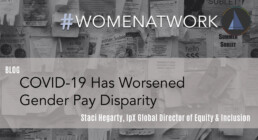Authentic DEI Change Demands Courage
Are you starting (or restarting) a diversity, equity, and inclusion initiative at work? That’s great! I am sincerely proud of you. If you are doing it right, you are probably feeling uncertain and maybe even a bit afraid of what is going to happen.
This kind of work, if done authentically and with the goal of transformative change, takes courage. Certainly not the courage that is required to be a person of color, a member of the LGBTQ+ community, a person with a disability, or any other marginalized person. But courage, nonetheless.
For every CEO who says they want to know the real results of their workforce equity and inclusion survey, there are far more who really only want to hear how well they are doing. Even more don’t want to do the survey because they are certain they know how their employees are feeling.
Many leaders want to check a box with a few hours of sensitivity training. Maybe bring in a motivational speaker or post a couple of things on the company intranet to celebrate X History Month. These things are nice, they really are. They can foster community and create shared experiences. They are not equity and inclusion initiatives that bring about change.
Transformative change requires the courage to face those employee surveys, reading every comment without coming up with excuses for why that negative response is an example of a disgruntled employee rather than accepting that there is something worth examining in that comment. Transformative change requires leaders to be intentional about creating a diverse workforce that is more than a headcount of the people of color on the payroll. It is a pay equity review that includes a solution for correcting inequities. It is a comprehensive review of policies and procedures to make sure they are truly inclusive. It is cultural competency training that requires employees to understand themselves and their own blind spots, not just to memorize a list of ways to not offend their colleagues. It is about implementing restorative justice techniques to help resolve conflicts. A lot of these things aren’t nice. They can be difficult and painful. Transformation is rarely nice as it is happening. This is the difference between repainting your living room (nice!) and renovating your entire kitchen by taking everything down to the studs and working with an architect to create a functional and modernized space (transformational!).
We all wish for a more inclusive and equitable world, whether at work, at school, or within our communities. If you are a leader, you must lead through the challenges and difficulties. As writer Elizabeth Gilbert said, “Stop wearing your wishbone where your backbone ought to be.”

The True Cost of Employee Turnover
Staci Hegarty, Envision RISE, Global Director of Equity & Inclusion
Turnover – there are a lot of reasons for it: the economy, company-wide reduction in force, new opportunity, automation, the employee was a “bad hire” or missed performance expectations, perhaps the employee had a life change that forced them to make a choice between their job and their other responsibilities, the list goes on and on. The uncertainty brought on by COVID-19 has only increased the problem, especially for women and more specifically, women of color.
Turnover sucks up time, money, resources, and morale. Most studies indicate that it costs a company approximately 30% of the departing employee’s salary to hire a replacement and may take up to two years for the new employee to gain proficiency in their role. That’s a cost of $15,000 to replace an employee making $45,000 a year! Are you wondering how that could be? Try this calculation to see how quickly the costs add up.
Of course, it is unrealistic to try to bring the employee turnover rate to zero (althoughI happen to work for a company that has managed to do just that for the past two years). Some things are outside of our control, such as a global pandemic. Instead of focusing on those things, focus on the other things. This is the part that can make leaders uncomfortable. What exactly is a “bad hire”? Was the employee truly bad? By that I mean were they grossly unqualified for the role, abusive, dangerous, or otherwise irredeemable? That really doesn’t happen that often.
What about the employee who leaves for a new opportunity? More money, flexible hours, better benefits or a promotion in title or responsibility are all very attractive. If another company sees the potential in your employee, why don’t you? After all, you actually know this person on some level. You probably know their strengths, their weaknesses and hopefully their career goals. Waiting until an employee gives their notice and then making a counteroffer to keep them sends the message that the better opportunity was always there, the company just had to be forced to offer it. If your process isn’t transparent and equitable it will alienate your employees and cause them to lose trust, even if they stay – for now.
Exit interviews are notoriously inaccurate for tracking the reason that employees voluntarily left the company. Very few people are willing to give the unvarnished truth if a culture is toxic, racist, sexist, homophobic or ableist, especially if the soon-to-be former employee needs to rely on the organization to provide a favorable reference in the future. No one wants to be labeled as overly sensitive, or as the person who “plays the race card,” or “can’t take a joke.” They may go to sites such as Glassdoor to post a scathing and anonymous review, but they won’t tell your Human Resources specialist.
If your company is trying to create a more diverse and inclusive culture, those online reviews may be hindering your efforts. If your open position ads say that you offer a diverse and inclusive culture, yet the anonymous reviews say otherwise, you are not going to achieve your goal. It may be time to get a third party involved. A baseline employee survey can offer valuable insights into your existing culture and help your senior leadership team formulate a plan to address the cultural issues that are impacting your turnover rates. What’s the ROI? Run the turnover cost calculation using the average salary at your company. Chances are it is less expensive to do the survey and have the results analyzed than it is to replace just a couple of employees. Diversity, Equity, and Inclusion initiatives don’t have to be all-encompassing to start making a difference, but they do have to start somewhere.
IpX’s RISE platform can support your organization’s efforts to create an inclusive environment that drives employee retention.
Beware the Echo Chamber
Michael Benning, IpX Executive Director, True North Enterprise Calibration
Creating diverse and equitable communities and workplaces begins with listening to one another. I’m white; I’m male, and I’m old enough to remember the evening news with Walter Cronkite. I’m isolated too – I live in Pleasantville, USA, in a subdivision with a gate. I didn’t set out to avoid people who don’t think like me – it just happened.
I’m in an echo chamber: to Walter’s dismay, I like getting my news from the small number of sources who ‘tell it like it is’ (that’s code for news that reinforces what I already believe). I interact with people every day with similar (or nearly identical) life experiences. Listening to alternate viewpoints doesn’t just happen. I believe social injustice in any form is absolutely wrong and completely unacceptable – but I can’t recall the last time I had a real conversation with someone dealing with it.
Creating diverse and equitable communities and workplaces does indeed begin with listening to one another – we have to be willing to exit our echo chambers.
But in the end, only doing counts. Build a bridge. If you’re ready to build, you might be interested in the following:
https://www.linkedin.com/pulse/white-men-four-things-you-can-do-advance-diversity-robert-e-moritz
https://hbr.org/2019/10/how-to-show-white-men-that-diversity-and-inclusion-efforts-need-them
https://www.forbes.com/sites/janicegassam/2018/09/03/how-to-get-white-men-on-board-with-diversity-and-inclusion-efforts/?sh=7e4181fb7694
Legacy Systems in Your Company’s Culture
Staci Hegarty, Vice President, Equity & Inclusion, Envision RISE
Most of us know what a legacy system is in software and computer systems. It’s the system that was chosen years ago, for reasons that may no longer be clear. Maybe the system works okay for now, but the fixes are expensive and time-consuming when they come up. Additional things have been added to your business, and the upgrades either don’t interface well with the legacy system or perhaps not at all, so there is another step added to the process. Maybe the legacy system still works fine for engineering, but it can’t support the rest of the enterprise.
In almost every meeting, the issue of a legacy system arises. Most people agree that it is a problem, but replacing a legacy system is not easy. First you have to establish requirements and decide on a good replacement, then you have to find the money. How will we make sure that critical information isn’t lost in the transition? Can current equipment even run the new system? How are we going to get everyone trained? How much time will be lost making the change? It’s complicated and messy and no one wants to do it even though everyone agrees it needs to be done. Like ignoring the small crack in the foundation of your house, it’s only going to get more difficult and more expensive to repair.
What does this have to do with inclusion and equity at work? Everything.
I work for a company that is best known for CM2, a configuration and change process management platform. Conventional configuration management focuses on manufacturing and engineering of a physical product – the processes and tools. Over the years CM2 has expanded to include the entire enterprise, recognizing that every organization has its own ecosystem – the processes, tools, and people. When we work with clients, one of the key factors in preparing to make a change is assessing the organizational readiness for change. The processes and tools won’t make much difference if the people aren’t ready. Before long, our organizational change management services were a swelling part of our model. We looked closer and it became clear that how people feel at work has a direct effect on how people perform at work. Not how they feel about their paychecks or their tasks, but how they feel about being a part of the workplace community. Do they feel that they belong and are accepted for who they are?
Legacy systems are not just software.
Legacy systems show up in our policies, job descriptions, hiring practices, incentive plans, and company celebrations. They are in our marketing and advertising. They are reflected in the Board of Directors. That doesn’t mean those systems are necessarily bad or intentionally biased, but we need to make sure they are evolving to meet the needs of our employees, our communities, and our customers. Just like technology, culture evolves. Chances are your workforce does not look like it did 30 years ago. Are you expecting to keep the same systems and force people to comply? They may try to conform for a while, but sooner or later they will find a job that embraces them instead of demanding that they leave who they are at the front door.
Conversations about diversity, equity, and inclusion (DEI) can make people very uncomfortable. The terms seem ambiguous, what does diversity even mean? For some people, the language of DEI is not only unfamiliar, it sounds like complaining or even blaming. It may even seem like some sort of trap, just waiting for an unsuspecting executive to say the wrong thing. Comprehensive DEI platforms are not a big game of “Gotcha!” They are designed to help companies get out of their own way. When we are able to understand where people are coming from, we can better serve them. When we look at our legacy systems in culture, we can make upgrades that make things easier for everyone.
Building a more equitable and inclusive workplace is just like replacing a legacy software system. It can be complex and even messy at times. It’s easy for organizations and their leadership to decide it isn’t worth the investment right now, that there are other things that are more important. For many, the approach is that if it seems to work okay for now, they will plan to budget for it in the next year or two. Meanwhile, the people who use it every day are wondering when something is going to be done because they know they can’t keep using the outdated system much longer. Organizations are more than products and tools; they are the people who work there, the customers who buy their products or services, and the communities of which they are a part. Creating a culture of belonging is not only possible, but necessary for innovation and growth.
Envision RISE is a training and services model to create an environment where all people are encouraged to draw upon their unique experiences, perspectives, and backgrounds to ensure sustainable long-term success of the organization. The RISE platform instills a novel way of thinking that focuses on fulfilling the needs of the individual and not simply an HR-centered initiative. This is an evolution from legacy Organizational Change Management (OCM) methods to a modern fit-for-purpose Organizational Evolution & Sustainability (OE&S) platform.
COVID-19 Has Worsened Gender Pay Disparity
Staci Hegarty, IpX Global Director of Equity & Inclusion
Before COVID-19, US women were already experiencing a significant gap in pay when compared with their male counterparts. On average, women earn 81.6 cents for every dollar that men earn, with median average earnings coming in at $9,766 less than men. March 31, 2020, marked the day that women earned what men earned in 2019. For women of color the numbers are more disheartening when compared with white men. Black women earn 62 cents for every dollar, Native women earn 57 cents and Latina women earn 54 cents.

Now, nearly six months into a global pandemic that forced the lucky ones to work at home and brought record-level unemployment to the rest, the inequity in women’s pay has become more obvious. Women fill more “essential” jobs than men, yet they also take on the majority of child-related jobs in the home. With daycares and schools not returning to normal operations, many women have had no choice but to leave their jobs. Even women who work from home have found that balancing work and family responsibilities has become even more challenging than before COVID-19.
As businesses begin to reopen, organizations need to take quick action to ensure that the women in their workforces are not left behind. Instead of seeing the reopening of some businesses as a chance to “get back to normal,” this is the time to acknowledge that the old way of operating was not working very well for half of employees. Not only do women need to be involved in how businesses resume operations, but they need to have the ability to raise concerns and work toward creative solutions to bring more gender equity to the workplace.
When organizations include all voices in the decision-making process, new ideas are brought forth. Innovative ways of working benefit not only the workers but also the company. With less turnover and an engaged workforce, energy and resources can be spent on the goals of the organization instead of trying to fix the problems brought on by doing things the way they have always been done.
Sources:
https://www.businessinsider.com/gender-wage-pay-gap-charts-2017-3
https://www.npr.org/2020/06/28/883458147/how-coronavirus-could-widen-the-gender-wage-gap
https://unglobalcompact.org/academy/how-business-can-support-women-in-times-of-crisis
Your Workforce is Waiting to See Action
Staci K. Hegarty M.Ed, IpX Academia Director
Protests and vigils have been on-going in the US for nearly two months. Debates over use-of-force by police, systemic racism, and the inequitable treatment of Black Americans at school, work and within our communities have dominated the national news cycle. By June, social media accounts of businesses of all sizes highlighted their mission and values, nearly always with a focus on supporting a culture of non-discrimination. But what happens after June and moving forward? When organizations ask the question, “Have we started the real work of anti-racism and anti-discrimination?” In general, the answer appears to be “not really.”

At the root of much of the inaction is fear. Fear of doing or saying the wrong thing. Fear of losing customers. Fear of not knowing where to begin. Fear of trying to change and still failing to create a diverse workforce. Fear of the unknown. Fear of change.
The small steps are the starting point. In order to truly create an inclusive workplace, an investment must be made in making diversity, equity, and belonging engrained in every part of the enterprise. Seek resources to help your organization move forward without feeling overwhelmed. Here are a few resources for improving your support for equality as a leader, closing the disability inclusion gap, and what it looks like to lead an anti-racist organization. For most companies, non-discrimination policies are based on employment law which differ from state to state.
Budgeting for training and full-time leadership roles that focus solely on creating an equitable culture is one key to success. It is more than “sensitivity training” once a year for a couple of hours; it is a full immersion in the language and behaviors that lead to a workplace that values all employees and encourages them to each bring their whole selves to work each day.
Keep an eye out for more OCM focused content as IpX unveils its RISE platform dedicated to Respect, Inclusion, Service and Equity in the workforce.





